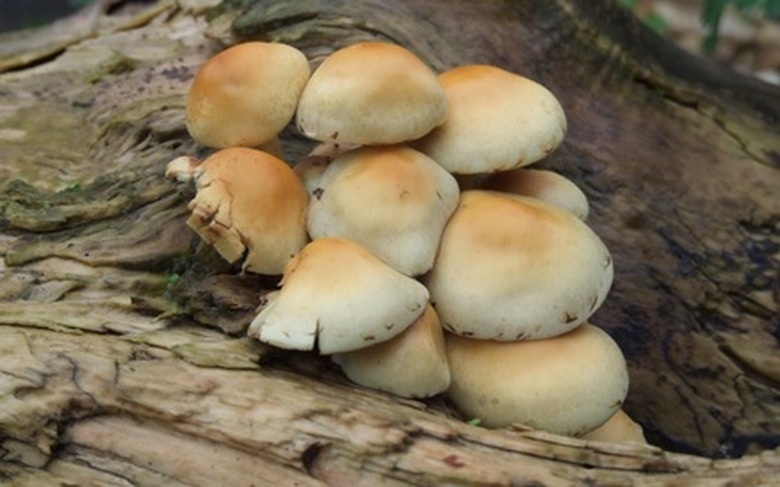Edible Mushrooms That Grow On Tree Bark
The kingdom Fungi is an amazingly diverse group of living things that decompose other organisms for food. Some types of fungi live on tree bark and decompose living trees. Most types of mushrooms that grow on trees are not mushrooms at all but polypores, or bracket fungi, and they will persist on a living tree until the tree dies. Some bracket fungi are edible or can be used for medicinal purposes. **It is always best to have mushrooms identified by an expert before eating, as many types of mushrooms that grow in your backyard can be poisonous.**
Warning
Have mushrooms identified by an expert before trying to eat the mushrooms. Many types of mushrooms, even those that grow in your backyard, can be poisonous.
What Types of Mushrooms Grow on Trees?
What Types of Mushrooms Grow on Trees?
One of the major phyla of fungi is Basidiomycota, which includes the gilled mushrooms that most people are familiar with. Most types of fungi that grow on tree bark are polypores, a type of basidiomycete. While many basidiomycetes have a traditional mushroom fruiting body with a stalk, cap and gills (where spores are produced and released), polypores don't have these parts. Instead, polypores grow a fruiting body called a conk that protrudes from the trunk of a tree much like a shelf (hence the nickname "shelf fungus") and has pores on its underside where its spores are located.
Most polypores, or bracket fungi, are very woody and therefore inedible, but there are a handful of edible mushroom species that grow on tree bark. They can make a very tasty meal with the proper identification and harvesting at an ideal time.
Edible Fungi That Grow on Trees
Edible Fungi That Grow on Trees
The sulfur shelf, or chicken-of-the-woods, is a recognizable polypore that is said to taste like chicken! Chicken-of-the-woods (Laetiporus sulphureus) can be easily identified due to its eye-catching orange color, large fruiting body size and wavy edges. The edible variety of Laetiporus grows on oak trees – do not eat these if you find them growing on conifers! Individual fruiting bodies can reach up to 12 inches long, and clusters of fruiting bodies can reach up to 24 inches long and weigh up to 50 pounds. The tender, new growth on the edges of the mushroom are the most edible part; older specimens may cause gastric upset.
Another popular type of fungus that grows on tree bark is the chaga mushroom, Inonotus obliquus, also known as the clinker polypore. This polypore doesn't look like a shelf at all, but rather a crinkly, cracked blackish mass growing on the bark of birch trees. Chaga mushrooms, while not necessarily edible, can be ground into a powder that is said to have amazing antioxidant abilities. However, chaga mushrooms may interact with certain medical conditions and medications in an adverse way.
Many other types of mushrooms that grow on trees are used for medicinal purposes but aren't good to eat. These can usually be dried and ground into a powder and later made into tea or added into smoothies. Examples of these types of bark mushrooms include artist's conk (Ganoderma applanatum), birch polypore (Piptoporus betulinus), turkey tail (Trametes versicolor) and reishi mushroom (Ganoderma tsugae).
One delicacy, the oyster mushroom, is a true mushroom and not a shelf fungus, that some say tastes like its name. This species of fungus (Pleurotus ostreatus) is worth mentioning because it does indeed grow on the bark of trees, favoring beech, oak and other broadleaf trees. Oyster mushrooms can now be seen as a specialty item at grocery stores, but mushroom hunters can find them in the wild at their peak in autumn or early winter.
Do Polypores Kill Trees?
Do Polypores Kill Trees?
If you notice polypores of any kind growing on a tree in your backyard, it may already be too late to save the tree. The fruiting body of a bracket fungus will appear only after the fungus has done significant damage to the inside of the tree. Most species of tree fungus will grow on the north side of the tree, and prefer shady locations. Polypores also prefer moist, cool, rainy conditions in coastal areas.
Polypores cause two types of rot, both of which will eventually kill a tree. Some bracket fungi cause white rot, where the fungus breaks down the lignin of the tree and leaves the white cellulose behind. These types of fungi grow slowly and might take three to five years to kill the tree. Examples of polypores that cause white rot are artist's conk, reishi and chaga.
The other type of rot caused by bracket fungi is called brown rot. Brown rot makes the woody parts of the tree turn dry and crumbly, and will kill the tree more quickly. Examples of polypores that cause brown rot are the beefsteak polypore, sulfur shelf and banded polypore.
Always Use Caution With Wild Mushrooms!
Always Use Caution With Wild Mushrooms!
It is crucial to properly identify any mushroom species you intend to eat. **Eating a misidentified mushroom can lead to illness and can even be fatal.** When considering eating wild mushrooms, it is important to have the help of an expert who has experience properly identifying and eating wild mushrooms. If you are identifying mushrooms on your own, it is best to consult a number of different field guides and not just a single source. Always consider the tree that the mushroom is associated with, as that can be an important factor with mushroom identification.
A common and very helpful saying of mushroom foragers is, "If in doubt, throw it out!"
Cite This Article
MLA
Reinbold, Joan. "Edible Mushrooms That Grow On Tree Bark" sciencing.com, https://www.sciencing.com/edible-mushrooms-that-grow-on-tree-bark-12391912/. 30 September 2021.
APA
Reinbold, Joan. (2021, September 30). Edible Mushrooms That Grow On Tree Bark. sciencing.com. Retrieved from https://www.sciencing.com/edible-mushrooms-that-grow-on-tree-bark-12391912/
Chicago
Reinbold, Joan. Edible Mushrooms That Grow On Tree Bark last modified March 24, 2022. https://www.sciencing.com/edible-mushrooms-that-grow-on-tree-bark-12391912/
